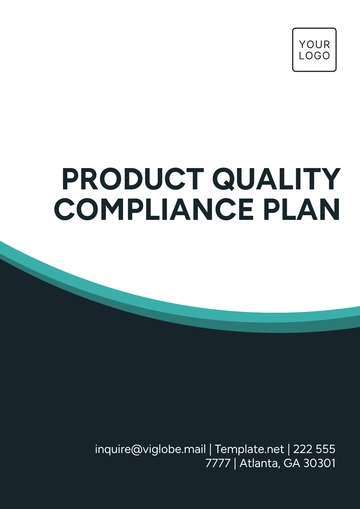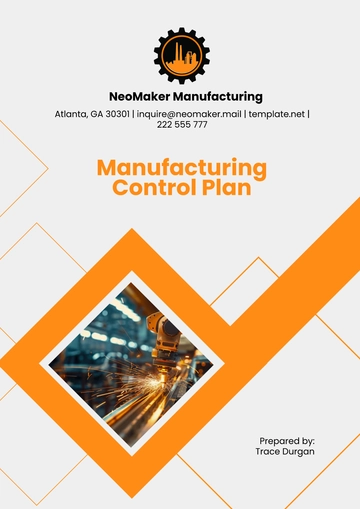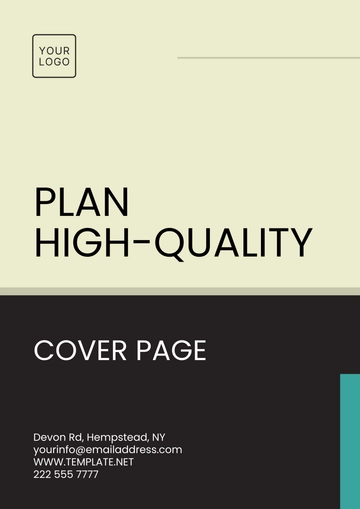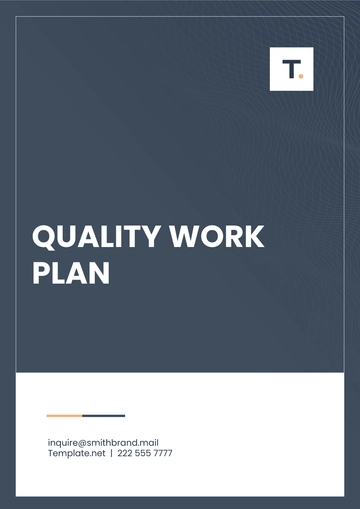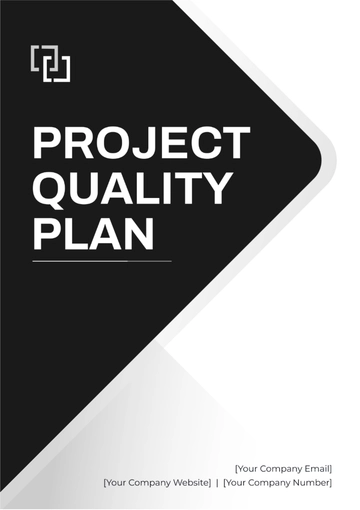Free Quality Work Plan
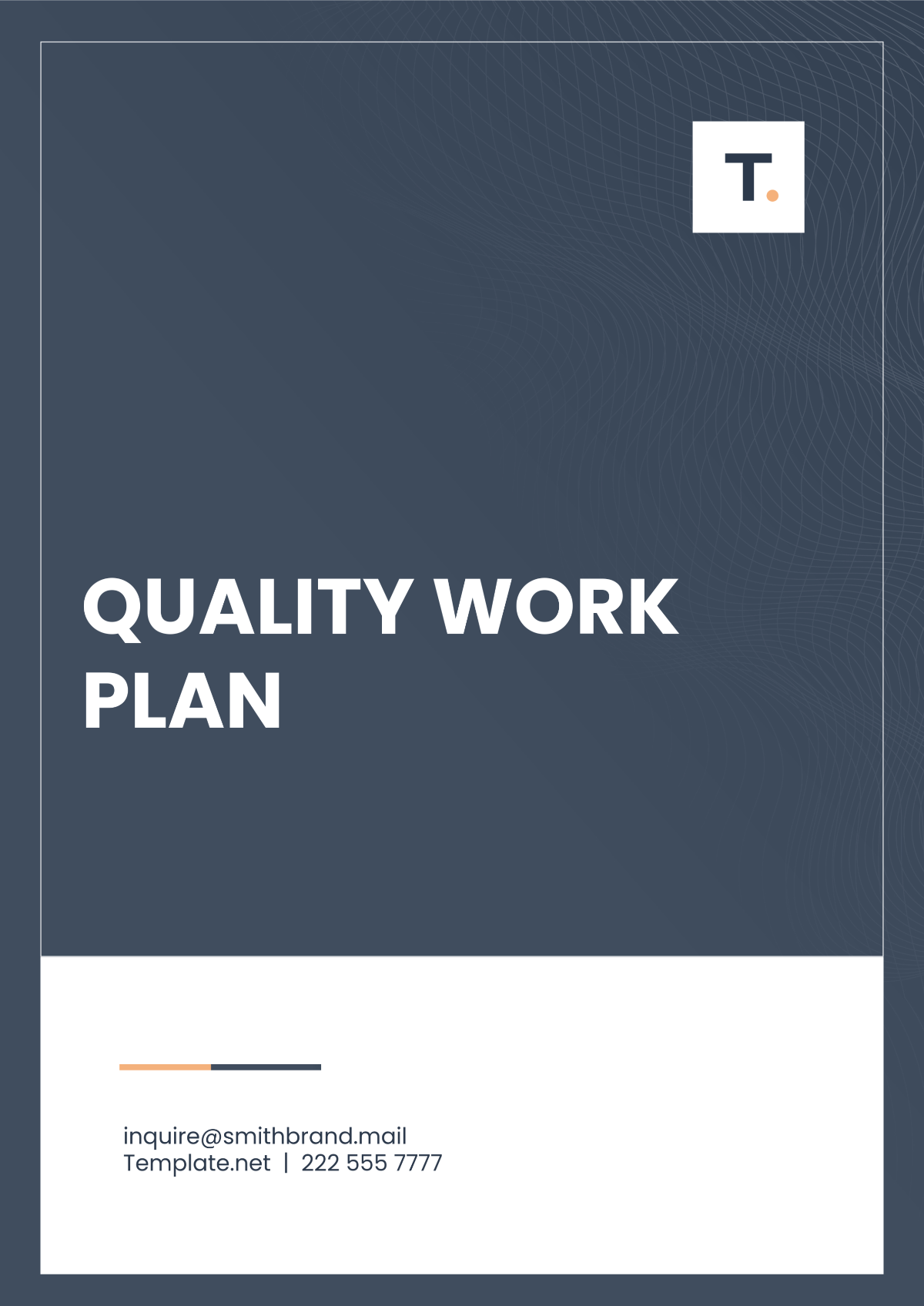
Prepared by: | [YOUR NAME] |
Company: | [YOUR COMPANY NAME] |
Department: | [YOUR DEPARTMENT] |
Date: | [DATE] |
I. Project Overview
[Your Company Name] is launching a CRM software system covering design, development, testing, and deployment to enhance customer interactions, data management, and sales strategies. This initiative aims to significantly boost customer satisfaction, sales efficiency, and decision-making.
A. Project Scope
Analysis of Current CRM Processes and Systems: Evaluate existing CRM workflows, data structures, and user interactions to identify inefficiencies and areas for improvement.
Design and Development of Customized CRM Software Solution: Create a tailored CRM software solution based on analyzed requirements, incorporating necessary features for efficient customer management and data tracking.
Integration with Existing Databases and Systems: Ensure the new CRM system integrates smoothly with existing databases to maintain consistent and accessible data.
Testing, Validation, and User Training: Test and validate the CRM software’s functionality, security, and usability, and train users on the system.
Deployment and Post-Launch Support: Implement, monitor, and continuously enhance the CRM system to maximize its effectiveness and user satisfaction across the organization.
B. Project Objectives
Goals:
Streamline Customer Interactions: Improve response times, automate routine tasks, and enhance customer data management.
Enhance Sales and Marketing: Provide sales teams with actionable insights, improve lead tracking, and enable targeted marketing campaigns.
Improve Operational Efficiency: Reduce manual errors, optimize workflows, and increase overall productivity.
Expected Impact on TechSolutions Inc.:
Customer Satisfaction: Reduced response times, personalized interactions, and improved service quality leading to higher customer satisfaction scores.
Sales Growth: Improved lead management, better cross-selling opportunities, and data-driven sales strategies resulting in increased revenue.
Operational Efficiency: Streamlined processes, reduced errors, and improved data accuracy leading to cost savings and better resource utilization.
II. Team Composition
A. Project Team Members
Project Manager: Porter Hoppe
Role: Overall project coordination, stakeholder communication, and timeline management.
Responsibilities: Ensuring project milestones, managing resources, and resolving project-level issues.
Technical Lead: Elvie Block
Role: Lead the technical aspects of CRM development, system architecture, and integration efforts.
Responsibilities: Designing software solutions, overseeing development tasks, and ensuring technical feasibility.
CRM Developer: Floyd Cremin
Role: Develop and customize CRM software based on project requirements and technical specifications.
Responsibilities: Coding, testing, debugging, and implementing CRM functionalities.
Quality Assurance (QA) Analyst: Trace Durgan
Role: Conduct comprehensive testing of CRM software, identify and report bugs, and ensure software quality standards.
Responsibilities: Test case creation, execution, regression testing, and collaborating with developers.
B. External Stakeholders
BlueLeaf
Role: External CRM Consultants
Contribution: Provide expertise in CRM best practices, system customization, and technical guidance.
GoWorld
Role: Database Integration Partner
Contribution: Assist in seamless integration between the new CRM system and existing databases, ensure data accuracy, and optimize database performance.
ZenExa
Role: Training and Documentation Experts
Contribution: Develop user training programs, create user manuals, and FAQs, and provide ongoing user support for CRM adoption and usage.
ViGlobe
Role: Post-Launch Support Partner
Contribution: Provide helpdesk support, troubleshoot user issues, monitor system performance post-launch, and collaborate with internal teams for bug fixes and updates.
III. Timeline and Milestones
A. Project Timeline
Project Start Date: April 1, 2050
B. Major Milestones
Project Kickoff Meeting - April 10, 2050
Activities: Introduce the project team, review the project scope, objectives, and deliverables, and finalize a project plan.
Phase 1: CRM Development and Testing
Phase Start Date: April 15, 2050
Phase Completion Date: June 15, 2050
Key Activities:
Requirement gathering and analysis
Design and development of core CRM functionalities
Initial testing and debugging
Feedback collection from stakeholders
Phase 2: Integration and User Training
Phase Start Date: June 20, 250
Phase Completion Date: August 15, 2050
Key Activities:
Integration with existing databases and systems
Data migration and validation
User training development and delivery
User acceptance testing (UAT) and refinement based on feedback
Phase 3: Deployment and Post-Launch Support
Phase Start Date: August 20, 2050
Phase Completion Date: September 30, 2050
Key Activities:
CRM system deployment across departments
Post-launch monitoring and support
Bug fixes, updates, and enhancements based on user feedback
Final user training sessions and documentation updates
Project Closure and Evaluation
Completion Date: October 15, 2050
Key Activities:
Project review meeting to assess achievements against initial objectives
Documentation of lessons learned, best practices, and areas for improvement
Handover of project deliverables and final reports
Celebration of project success and recognition of team contributions
IV. Resources and Budget
Budget Allocation: $500,000
Development and Integration
Testing and Quality Assurance
Training and Documentation
Hardware and Software
Project Management and Support
Human Resources: $610,000
Technical Staff
Project Management and Support
Material Resources: $80,000
Software Licenses
Hardware
Other Technical Tools
Financial Resources: $500,000
Phase 1 (Development and Testing)
Phase 2 (Integration and Training)
Phase 3 (Deployment and Support)
Contingency Reserve
V. Risk Management
A. Identification of Risks
Technical Challenges: Integration complexities, software bugs, or compatibility issues.
Resource Constraints: Shortage of skilled personnel, equipment, or budget limitations.
Timeline Delays: Unexpected dependencies, scope changes, or external factors.
Data Security Risks: Data breaches, unauthorized access, or data loss during integration.
User Adoption Issues: Resistance to change, lack of training, or usability concerns.
B. Mitigation Strategies
Technical Challenges:
Conduct thorough testing and prototyping phases.
Regular code reviews and collaboration among technical teams.
Maintain clear documentation and version control.
Resource Constraints:
Hire additional staff or outsource critical tasks.
Optimize resource utilization through efficient task allocation.
Monitor the budget closely and adjust priorities if needed.
Timeline Delays:
Use agile project management methodologies for flexibility.
Identify and address critical path activities early.
Regular progress tracking and proactive issue resolution.
Data Security Risks:
Implement robust data encryption and access control measures.
Regular security audits and vulnerability assessments.
Backup and recovery plans for critical data.
User Adoption Issues:
Develop comprehensive training programs and user documentation.
Involve end-users in the design and testing phases for feedback.
Provide ongoing support and address user concerns promptly.
VI. Quality Assurance
A. Quality Goals
Functional Accuracy: Ensure all CRM functionalities work as intended without errors or unexpected behavior.
Performance Efficiency: Optimize system response times and resource utilization for a smooth user experience.
Data Integrity: Maintain data accuracy, consistency, and security throughout the CRM system.
User Experience: Provide an intuitive user interface, easy navigation, and comprehensive help documentation.
Compliance: Adhere to industry standards, data protection regulations, and internal security policies.
B. Evaluation and Reporting
Testing and Evaluation Procedures:
Unit Testing: Test individual CRM components for functionality and correctness.
Integration Testing: Verify seamless integration with existing systems and data accuracy.
Performance Testing: Assess system response times, load handling, and scalability.
User Acceptance Testing (UAT): Involve end-users to validate system usability, workflows, and feature acceptance.
Security Testing: Conduct vulnerability assessments, penetration testing, and data security audits.
Reporting Schedule and Format:
Weekly Progress Reports: Provide updates on testing progress, identified issues, and resolutions.
Bi-weekly Quality Metrics: Measure and report on key quality indicators such as bug density, test coverage, and performance benchmarks.
Pre-Deployment Checklist: Ensure all quality criteria are met before each deployment phase.
Post-Deployment Monitoring: Continuously monitor system performance, and user feedback, and address any post-launch issues promptly.
Quality Assurance Outcomes:
Defect Tracking: Document and track identified defects using a centralized system.
Root Cause Analysis: Conduct root cause analysis for critical defects to prevent recurrence.
Quality Reviews: Hold regular quality review meetings to discuss findings, improvements, and lessons learned.
VII. Communication Plan
A. Internal Communication
Frequency:
Weekly team meetings to discuss progress, challenges, and action items.
Bi-weekly project status updates to stakeholders and senior management.
Ad-hoc meetings as needed for urgent issues or decision-making.
Modes of Communication:
Email for official announcements, meeting agendas, and detailed updates.
Project management software (Jira, Asana) for task assignments, progress tracking, and collaboration.
Instant messaging platforms (lack, Microsoft Teams) for quick discussions, queries, and updates.
Video conferences for remote team members or detailed discussions requiring visual aids.
B. External Communication
Stakeholder Engagement Strategies:
Regular progress reports and status updates tailored to stakeholders' interests and concerns.
Quarterly stakeholder meetings to review project milestones, address feedback, and align expectations.
Stakeholder surveys or feedback sessions to gather input and improve project alignment.
Customer Updates and Public Relations Management:
Customer newsletters or emails highlighting new CRM features, benefits, and usage tips.
Webinars or online training sessions for customers to familiarize them with the new system.
Public relations (PR) efforts such as press releases, blog posts, or social media updates about project milestones, success stories, and customer testimonials.
Dedicated customer support channels (phone, email, ticketing system) for prompt assistance and issue resolution.
- 100% Customizable, free editor
- Access 1 Million+ Templates, photo’s & graphics
- Download or share as a template
- Click and replace photos, graphics, text, backgrounds
- Resize, crop, AI write & more
- Access advanced editor
Achieve top-tier quality with our Quality Work Plan Template from Template.net. This editable and customizable tool elevates quality control processes to ensure excellence. Precisely tailor workflows, standards, and assessments using our intuitive Ai Editor Tool. Empower teams to meet and exceed quality benchmarks by customizing plans to specific project needs. Streamline operations and uphold high standards with a comprehensive template
You may also like
- Finance Plan
- Construction Plan
- Sales Plan
- Development Plan
- Career Plan
- Budget Plan
- HR Plan
- Education Plan
- Transition Plan
- Work Plan
- Training Plan
- Communication Plan
- Operation Plan
- Health And Safety Plan
- Strategy Plan
- Professional Development Plan
- Advertising Plan
- Risk Management Plan
- Restaurant Plan
- School Plan
- Nursing Home Patient Care Plan
- Nursing Care Plan
- Plan Event
- Startup Plan
- Social Media Plan
- Staffing Plan
- Annual Plan
- Content Plan
- Payment Plan
- Implementation Plan
- Hotel Plan
- Workout Plan
- Accounting Plan
- Campaign Plan
- Essay Plan
- 30 60 90 Day Plan
- Research Plan
- Recruitment Plan
- 90 Day Plan
- Quarterly Plan
- Emergency Plan
- 5 Year Plan
- Gym Plan
- Personal Plan
- IT and Software Plan
- Treatment Plan
- Real Estate Plan
- Law Firm Plan
- Healthcare Plan
- Improvement Plan
- Media Plan
- 5 Year Business Plan
- Learning Plan
- Marketing Campaign Plan
- Travel Agency Plan
- Cleaning Services Plan
- Interior Design Plan
- Performance Plan
- PR Plan
- Birth Plan
- Life Plan
- SEO Plan
- Disaster Recovery Plan
- Continuity Plan
- Launch Plan
- Legal Plan
- Behavior Plan
- Performance Improvement Plan
- Salon Plan
- Security Plan
- Security Management Plan
- Employee Development Plan
- Quality Plan
- Service Improvement Plan
- Growth Plan
- Incident Response Plan
- Basketball Plan
- Emergency Action Plan
- Product Launch Plan
- Spa Plan
- Employee Training Plan
- Data Analysis Plan
- Employee Action Plan
- Territory Plan
- Audit Plan
- Classroom Plan
- Activity Plan
- Parenting Plan
- Care Plan
- Project Execution Plan
- Exercise Plan
- Internship Plan
- Software Development Plan
- Continuous Improvement Plan
- Leave Plan
- 90 Day Sales Plan
- Advertising Agency Plan
- Employee Transition Plan
- Smart Action Plan
- Workplace Safety Plan
- Behavior Change Plan
- Contingency Plan
- Continuity of Operations Plan
- Health Plan
- Quality Control Plan
- Self Plan
- Sports Development Plan
- Change Management Plan
- Ecommerce Plan
- Personal Financial Plan
- Process Improvement Plan
- 30-60-90 Day Sales Plan
- Crisis Management Plan
- Engagement Plan
- Execution Plan
- Pandemic Plan
- Quality Assurance Plan
- Service Continuity Plan
- Agile Project Plan
- Fundraising Plan
- Job Transition Plan
- Asset Maintenance Plan
- Maintenance Plan
- Software Test Plan
- Staff Training and Development Plan
- 3 Year Plan
- Brand Activation Plan
- Release Plan
- Resource Plan
- Risk Mitigation Plan
- Teacher Plan
- 30 60 90 Day Plan for New Manager
- Food Safety Plan
- Food Truck Plan
- Hiring Plan
- Quality Management Plan
- Wellness Plan
- Behavior Intervention Plan
- Bonus Plan
- Investment Plan
- Maternity Leave Plan
- Pandemic Response Plan
- Succession Planning
- Coaching Plan
- Configuration Management Plan
- Remote Work Plan
- Self Care Plan
- Teaching Plan
- 100-Day Plan
- HACCP Plan
- Student Plan
- Sustainability Plan
- 30 60 90 Day Plan for Interview
- Access Plan
- Site Specific Safety Plan
